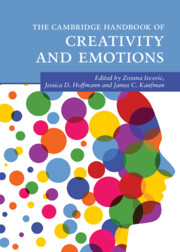Book contents
- The Cambridge Handbook of Creativity and Emotions
- Cambridge Handbooks in Psychology
- The Cambridge Handbook of Creativity and Emotions
- Copyright page
- Dedications
- Contents
- Figures
- Tables
- Contributors
- Acknowledgments
- Creativity and Emotions
- Part I Methods in the Study of Creativity and Emotions
- Part II The Development of Creativity
- 5 Affective States and Creativity
- 6 The Neuroscience of Creativity and Emotions
- 7 Attention, Affect, and Creativity, from Mindfulness to Mind-Wandering
- 8 Motivations, Emotions, and Creativity
- 9 Managing Difference and Uncertainty and Creativity
- 10 Creativity and Emotional Intelligence
- 11 Emotions across the Creative Process and across Domains of Creativity
- Part III Emotions and the Creative Person
- Part IV Emotions and Creative Products
- Part V Emotions and Creativity at School and Work
- Index
- References
6 - The Neuroscience of Creativity and Emotions
from Part II - The Development of Creativity
Published online by Cambridge University Press: 16 February 2023
- The Cambridge Handbook of Creativity and Emotions
- Cambridge Handbooks in Psychology
- The Cambridge Handbook of Creativity and Emotions
- Copyright page
- Dedications
- Contents
- Figures
- Tables
- Contributors
- Acknowledgments
- Creativity and Emotions
- Part I Methods in the Study of Creativity and Emotions
- Part II The Development of Creativity
- 5 Affective States and Creativity
- 6 The Neuroscience of Creativity and Emotions
- 7 Attention, Affect, and Creativity, from Mindfulness to Mind-Wandering
- 8 Motivations, Emotions, and Creativity
- 9 Managing Difference and Uncertainty and Creativity
- 10 Creativity and Emotional Intelligence
- 11 Emotions across the Creative Process and across Domains of Creativity
- Part III Emotions and the Creative Person
- Part IV Emotions and Creative Products
- Part V Emotions and Creativity at School and Work
- Index
- References
Summary
The neuroscience of creativity has grown significantly over the past several years. One aspect of creative ideation that has been relatively understudied, however, is how emotional processes—and the neural systems underlying them—shape creativity. Creativity, like its muse, can be ephemeral: vulnerable to internal and external environmental factors that spark new ideas or snuff them out, and emotions can modulate these effects. In this chapter, we review findings underscoring the critical interactions between cognitive and emotional neuromodulatory mechanisms during creative thinking, including the potential impact of mood, stress, and reward processes on known neurocognitive components of creative ideation. We further examine whether and under what circumstances such interactions can have positive or negative consequences for creativity. Lastly, we discuss how emotional task content may impact the generation of the creative product on the part of the creator. Across these domains, we synthesize this literature and propose a framework for future research that integrates brain function at the neurochemical, neuroanatomical, and systems levels with emotional aspects of creative thinking.
- Type
- Chapter
- Information
- The Cambridge Handbook of Creativity and Emotions , pp. 109 - 129Publisher: Cambridge University PressPrint publication year: 2023
References
- 1
- Cited by



